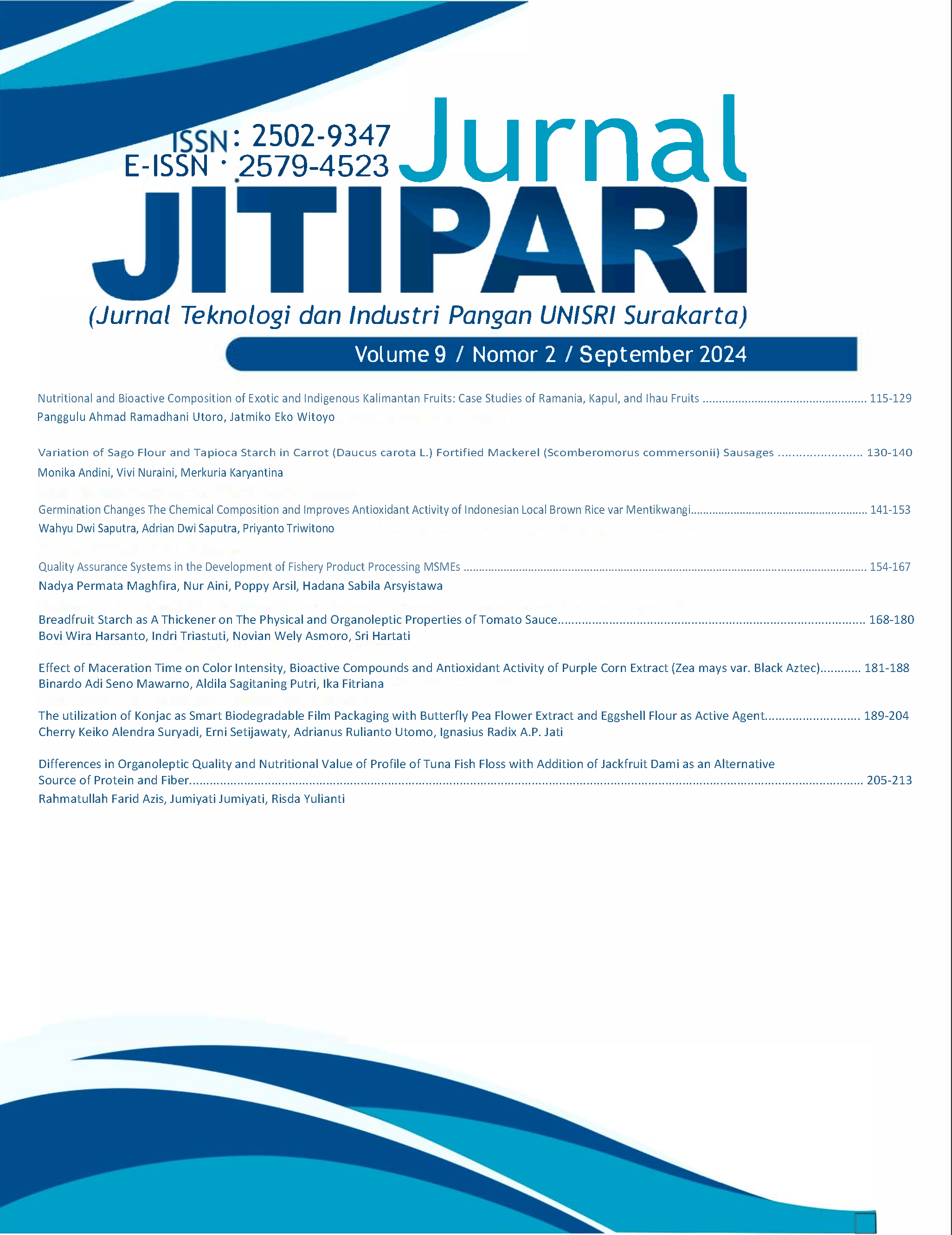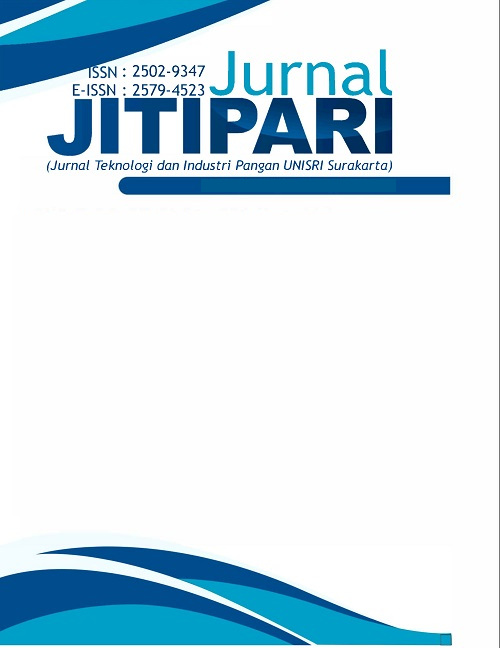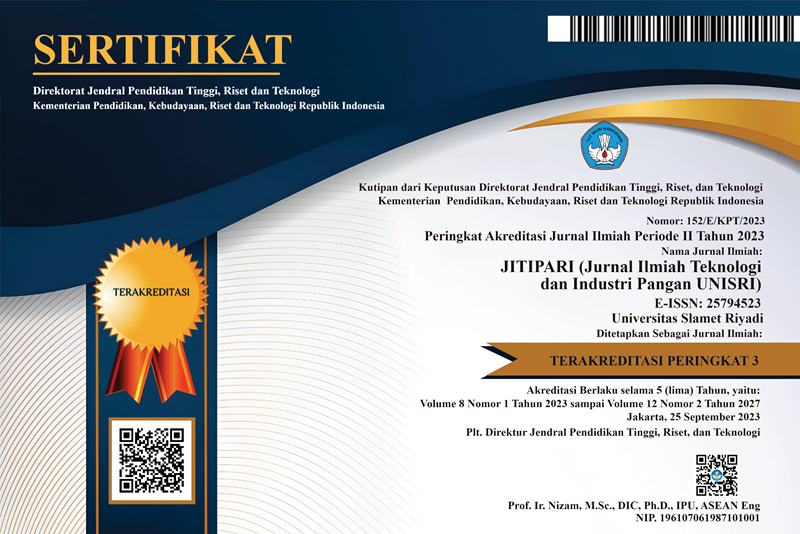Effect of Maceration Time on Color Intensity, Bioactive Compounds and Antioxidant Activity of Purple Corn Extract (Zea mays var. Black Aztec)
Pengaruh Lama Maserasi Terhadap Intensitas Warna, Senyawa Bioaktif dan Aktivitas Antioksidan Ekstrak Jagung Ungu (Zea mays var. Black Aztec)
DOI:
https://doi.org/10.33061/jitipari.v9i2.10219Abstract
Purple corn is one of the corn varieties that is being developed by Indonesia as a form of food diversification. The purple color of corn is produced by the high presence of anthocyanins so it can provide health benefits such as antioxidant, anti-inflammatory, mutagenic, anti-cancer and anti-angiogenesis. To ensure that the bioactive components are not damaged, extraction is carried out in stages by applying the maceration method using a polar solvent with the correct ethanol content of 96%. Apart from using the appropriate solvent, the length of maceration time will determine the results of the extract obtained. This research aims to find out how long maceration affects the content of bioactive compounds found in purple corn. The research used a completely randomized design with one treatment, namely maceration times of 12, 24 and 48 hours. The tests carried out included color intensity, total phenol and anthocyanin content and antioxidant activity. The research findings explain that the length of maceration has a significant effect on color intensity, total phenols and antioxidant activity of purple corn extract. 2 hour maceration was the best treatment in extracting bioactive compounds, namely total phenols of 206.29 g/100 g, total anthocyanins of 0.19 g/100 g and antioxidant activity of 58.80%.
References
Amanda, A., Kurniaty, I., Kunci, K., Alami, P., & Ungu, T. (2017). Pengaruh waktu maserasi terhadap rendemen zat antosianin pewarna alami minuman jelly dari terong ungu. Seminar Nasional Sains Dan Teknologi, 1–7.
Amelinda, E., Wayan Rai Widarta, I., & Putu Trisna Darmayanti, L. (2018). Pengaruh waktu maserasi terhadap aktivitas antioksidan ekstrak rimpang temulawak (Curcuma xanthorriza Roxb.). Ilmu Dan Teknologi Pangan, 7(4), 165–174.
Balai Riset Tanaman Serealia. (2017). Komoditas Jagung Ungu. Balai Riset dan Pengembangan Riset Kementrian Pertanian.
Chalid, A. I., Hanafi, Jahuddin Rahmat, & H.M.Yasin HG. (2022). Analisis karakter agronomi jagung pulut dan jagung ungu berdasarkan sebaran hottelings. Jurnal Ilmiah Indonesia, 7(4), 4834 –4843.
Chayati, I., . S., Marsono, Y., & Astuti, M. (2020). Pengaruh varietas, fraksi pengayakan, dan jenis pelarut terhadap kadar antosianin, total fenolik, dan aktivitas antioksidan ekstrak jagung ungu. Jurnal Riset Teknologi Industri, 14(1), 13–26. https://doi.org/10.26578/jrti.v14i1.5399.
Faidah, N; Febrina, D; Prabandari, R & Silvia, A. (2024). Uji aktivitas antioksidan fraksi air, n-heksan, dan etil asetat ekstrak etanol biji jagung ungu (Zea mays var ceratina kulesh). Jurnal Ilmia Farmasi Terapan & Kesehatan, 2(1) : 28-43
Farida, R., & Choirun Nisa, F. (2015). Ekstraksi antosianin limbah kulit manggis metode microwave assisted extraction (lama ekstraksi dan rasio bahan: pelarut). Jurnal Pangan Dan Agroindustri, 3(2), 362–373.
Fernandez‐ Aulis, F., Hernandez‐ Vazquez, L., Aguilar‐ Osorio, G., Arrieta‐ Baez, D., & Navarro‐ Ocana, A. (2019). Extraction and identification of anthocyanins in corn cob and corn husk from cacahuacintle maize. Journal of Food Science, 84(5), 954-962. https://doi.org/10.1111/1750-3841.14589.
Harakotr, B., Suriharn, B., Tangwongchai, R., Scott, M. P., dan Lertrat, K. (2014). Anthocyanins and antioxidant activity in coloured waxy corn at different maturation stages. Journal of Functional Foods, 9, 109–118. https://doi.org/10.1016/j.jff.2014.04.012.
Hu, Q.P., dan Xu, J.G. (2011). Profiles of carotenoids, anthocyanins, phenolics, and antioxidant activity of selected color waxy corn grains during maturation. Journal of Agricultural and Food Chemistry, 59(5), 2026–2033. https://doi.org/10.1021/jf104149q.
Irnawati, Zubaydah, W. O. S., & Arifah. (2017). Anthocyanin total and antioxidant activity of ruruhi (Syzygium polycephalum merr.) fruits. Jurnal Ilmiah Farmasi-UNSRAT, 6(3).
Jing, P. 2006. Purple corn anthocyanins: chemical structure, chemoprotective activity and structure / function relationships. Disertasi. The Ohio State University. Columbus. Ohio
Kohartono, G., Sutedja, A. M., & Widyawati, S. (2014). Perubahan kadar senyawa bioaktif dan aktivitas antioksidan beras organik hitam varietas jawa dengan pengemas polipropilen selama enam bulan penyimpanan. Teknologi Pangan Dan Gizi, 13(2), 69–74.
Kristiani, V. dan F.I. Halim. (2014). Pengaruh konsentrasi etanol dan waktu maserasi terhadap perolehan fenolik, flavonoid dan aktivitas antioksidan ekstrak rambut jagung. (Skripsi). Fakultas Teknik. Universitas Katolik Widya Mandala, Surabaya.
Lanez, T., & Haoua, K. ben. (2017). The effect of soxhlet and ultrasonic-assisted extraction on antioxidant components and antioxidants properties of selected south algerian red potatoes cultivars. Chemistry and Chemical Engineering Biotechnology, Food Industry, 18(4), 435–448.
Lao, F., Sigurdson, G. T., & Giusti, M. M. (2017). Health benefits of purple corn (Zea mays L.) phenolic compounds (Review). Comprehensive Reviews in Food Science and Food Safety, 16(2), 234–246. https://doi.org/10.1111/1541-4337.12249.
Li, C.Y., Kim, H.W., Li, H., Lee, D.C., dan Rhee, H.I. (2014). Antioxidative effect of purple corn extracts during storage of mayonnaise. Food Chemistry, 152, 592–596. https://doi.org/10.1016/j.foodchem.2013.11.152
Lorena, C., Malaver, V., Julia, A., Dulcey, C., Hipólito, J., & Martínez, I. (2015). Comparison of DPPH Free Radical Scavenging, Ferric Reducing Antioxidant Power (FRAP), and Total Phenolic Content of Two Meriania Species (Melastomataceae).
Mongkolsilp, S., Pongbupakit, I., Sae-Lee, N., & Sitthithaworn, W. (2004). Radical scavenging activity and total phenolic content of medicinal plants used in primary health care. In SWU J Pharm Sci., 9(1).
Moulana, R., Rohaya, S., Ria Rosika, dan, Teknologi Hasil Pertanian, J., & Pertanian, F. (2012). Efektivitas penggunaan jenis pelarut dan asam dalam proses ekstraksi pigmen antosianin kelopak bunga rosella (Hibiscus sabdariffa L). Jurnal Teknologi Dan Industri Pertanian Indonesia, 4.
Napan, L.E., Vietti-Guzmán, F.F., Alvarez-Yanamango, E.G., dan Huayta, F.V. (2018). Evaluation of some functional properties of purple corn (Zea mays L.) dye, during its processing at pilot scale. 16th LACCEI International Multi-Conference for Engineering, Education, and Technology: “Innovation in Education and Inclusion”, 19-21 July 2018, Lima, Peru. http://dx.doi.org/10.18687/LACCEI2018.1.1.290.
Prasetya, I. W. G. A., Putra, G., & Wrasiati Luh Putu. (2020). Pengaruh jenis pelarut dan waktu maserasi terhadap ekstrak kulit biji kakao (Theobroma cacao L.) sebagai sumber antioksidan. Jurnal Rekayasa Dan Managemen Agroindustri, 8, 150–159.
Prayitno, S. A. and Rahim, A. R. 2020. The comparison of extracts (ethanol and aquos solvents) Muntingia calabura leaves on total phenol, flavonid and antioxidant (IC50) properties, Kontribusia (Research Dissemination for Community Development), 3(2), 319 doi:10.3058/kontribusia.v3i2.1451
Ramos-Escudero, F., Muñoz, A. M., Alvarado-Ortíz, C., Alvarado, Á., dan Yáñez, J.A. (2012). Purple corn (Zea mays L.) phenolic compounds profile and its assessment as an agent against oxidative stress in isolated mouse organs. Journal of Medicinal Food, 15(2), 206– 215. https://doi.org/10.1089/jmf.2010.0342
Saleh, L. P., Suryanto, E., & Yudistira, A. (2012). Aktivitas antioksidan dari ekstrak tongkol jagung (Zea mays L.). PHARMACON, 1(2). https://doi.org/10.35799/pha.1.2012.465
Siregar, Y. D. I., & Nurlela. (2011). Ekstraksi dan uji stabilitas zat warna alami dari bunga kembang sepatu (Hibiscus rosa-sinensis L) dan bunga rosela (Hibiscus sabdariffa L), Jurnal Valensi, 2(3).
Wahyuni, D. T., & Widjanarko, S. B. (2015). Pengaruh jenis pelarut dan lama ekstraksi terhadap ekstrak karotenoid labu kuning dengan metode gelombang ultrasonik. Jurnal Pangan Dan Agroindustri, 3(2), 390–401.
Downloads
Published
How to Cite
Issue
Section
License
Copyright (c) 2024 Binardo Adi Seno Mawarno, Aldila Sagitaning Putri, Ika Fitriana

This work is licensed under a Creative Commons Attribution-ShareAlike 4.0 International License.
Authors who publish this journal agree to the following terms:
- Authors retain copyright and grant the journal right of first publication with the work simultaneously licensed under a Creative Commons Attribution-ShareAlike 4.0 International (CC BY-SA 4.0) that allows others to share the work with an acknowledgement of the work's authorship and initial publication in this journal.
- Authors can separately make additional contractual arrangements for non-exclusive distribution published by the journal (e.g., publish it in a book), with an acknowledgement of its initial publication in this journal.
- Authors are allowed and encouraged to send their work via online (e.g., in the institutional repositories or their website) after published by the journal.










